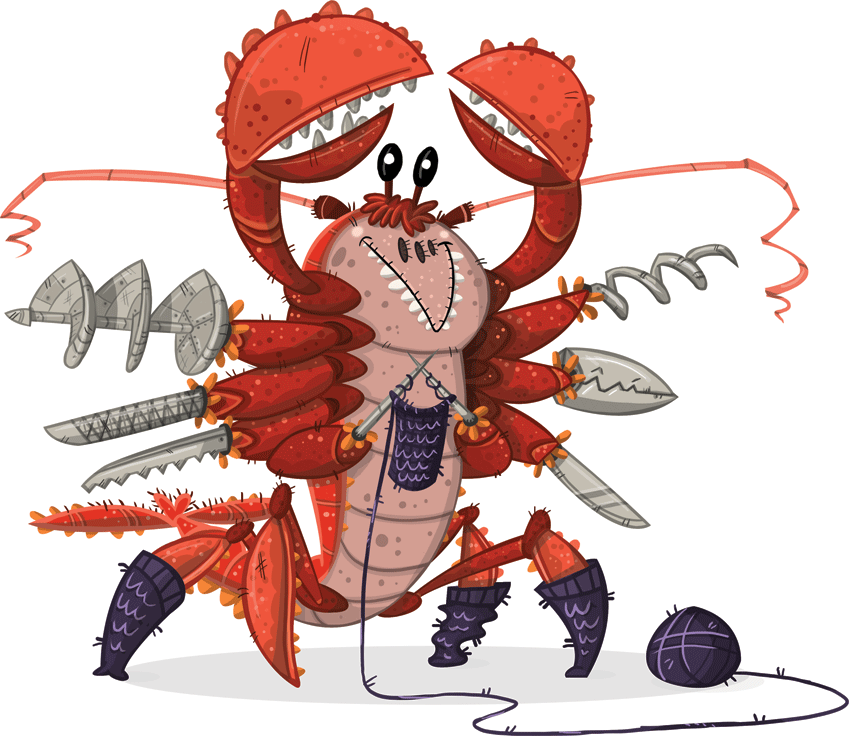

These are small monsters in the lobster family. They have lots of friendly teeth and strange legs. They hide under upside-down buckets in the garden, waiting for slugs and snails. They prefer to roast their food over a candle, and they shelter under the bucket to avoid wind and rain that might put the candle out.
They are very loving, and like to be cuddled, but don’t let one get too close. If you do, you will discover that they have spiky skin and very bad breath because none of their legs has a toothbrush on the end of it. Even the bucket bogles admit their breath is a problem—it is dreadful enough to put their candles out. Sometimes, it’s even enough to make the candles run away.
Bucket bogles will live quite happily inside a piece of cloth or a bag, and bogle breeders have now developed a smooth-skinned strain that lives quite happily in pockets. This strain is sold in good pet shops as the pocket bogle. These have orange hair between their toes, and blue hair between their teeth, and are trained to brush their teeth (but not between their toes, and you have to buy them a new brush, once a month), so they do not smell anywhere near as bad as the ordinary garden bucket bogle. The pocket bogles smell even better if they are fed on celery, the outside leaves of lettuce, strawberries and a few dried bread crusts.
If you have a pet bucket bogle, be very careful about letting it juggle things that are either soft or fragile. If you are wondering why this is a problem, read up on what they have on the end of their legs, and you will start to see why it is unsafe to let them juggle kittens, fruit or wine glasses. The bucket bogle will be sorry afterwards, but not as sorry as the kitten.

ORIGINS: These monsters seem to have spread from their original home in the Amazon jungles to most parts of the world. There are no buckets in the Amazon jungles, but they used to collect old tortoise shells and live under those.
SIZE: Small enough to fit neatly in a pocket, though this must never be tried with bucket bogles from your garden, because their breath is bad enough to rot the stitching in your clothes, which could be very embarrassing.
UNUSUAL THINGS: They are land lobsters, so they have 14 legs, with different endings, but they only use the back two pairs of legs to walk.
IS A THREAT TO: Snails, slugs, noses and pockets. They eat cannibal corks when they can catch them. While they aren’t exactly a threat to kittens, fruit or wine glasses, they don’t improve them, either! They don’t like brown paper parcels tied up in string very much, and attack them whenever they see them.
USES: The bad breath acts as a snail and slug repellent, which sometimes makes it hard for them to catch any dinner. Any painted object left in a bogle’s bucket for 24 hours will have all of the paint stripped off it. Just one bogle in the garden will keep the slugs and snails under control.
HATES: Gobblesocks, which steal their socks while they are sleeping after a big meal, pudding monsters which knock over their buckets. The idea of eating raw food makes them very miserable, and when they think of raw food, they start sighing deeply, which usually blows their candle out. They really hate that.
LIKES: Buckets and being near saltwater warthogs.

The bucket bogle has 14 legs, and is also known as the Swiss Army prawn on account of the endings of its legs. The front legs each have a pair of nippers which they can use to hold their food over the candle flame, the next pair are a corkscrew (left) and auger (right), the third pair have a wire stripper (left—the juvenile bogles sometimes eat electrical insulation) and a nail file (right). The fourth pair are cutting blade (left) and saw blade (right), the fifth pair are knitting needles. They use the knitting needles to make small socks for the sixth and seventh pairs, which they use for walking.